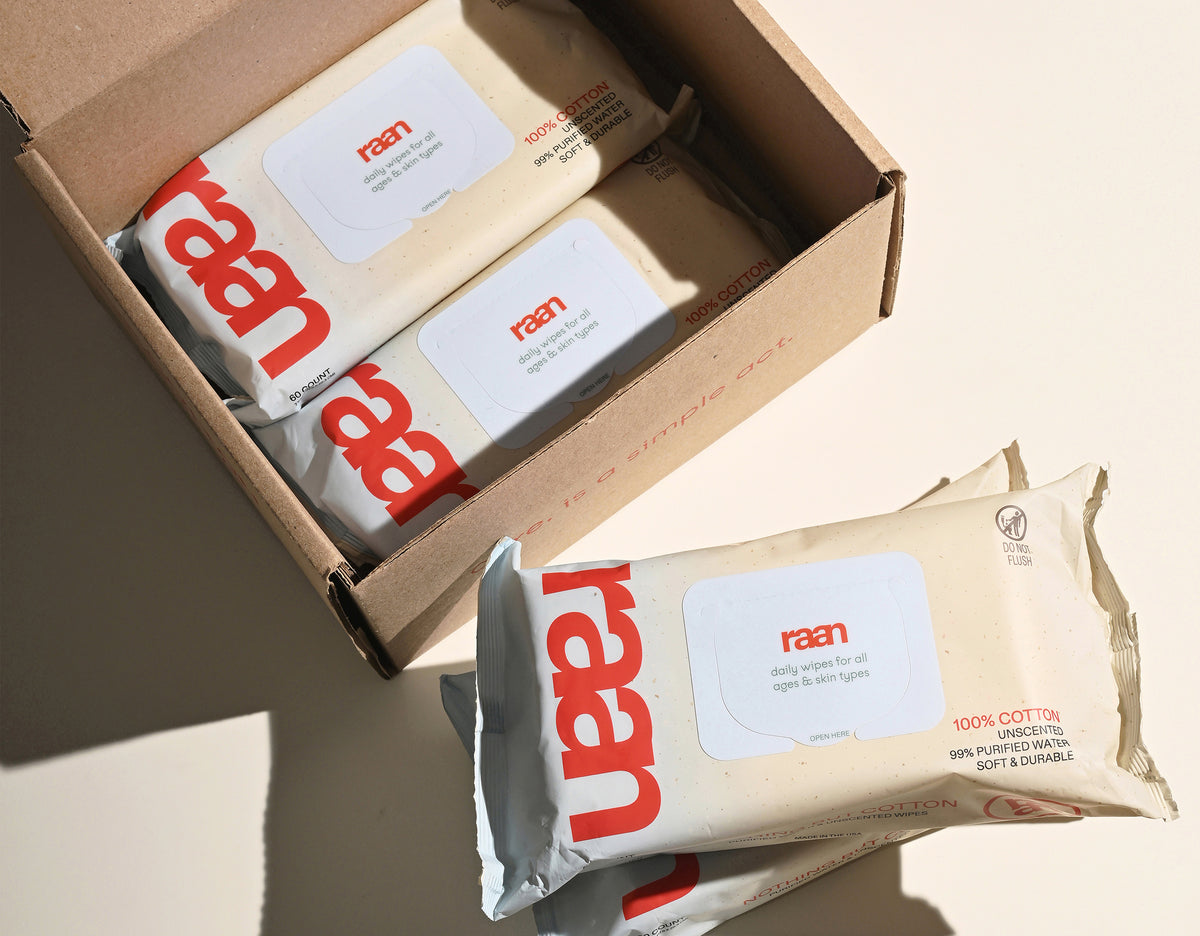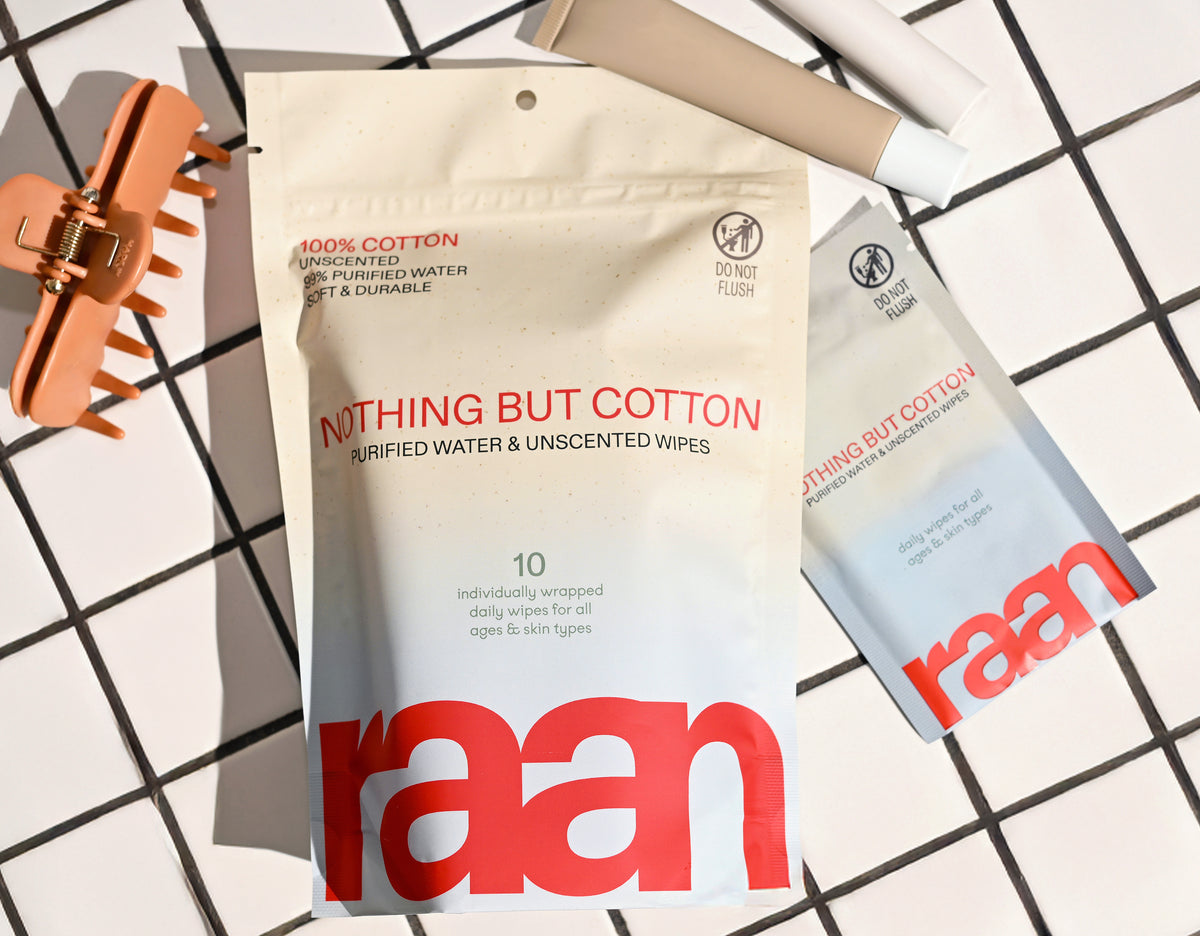Finding the best cotton wipes shouldn't feel like decoding a chemistry textbook. Yet here we are, squinting at ingredient lists packed with unpronounceable additives, wondering if what we're putting on our skin — or our baby's skin — is actually safe.
Key Takeaways
- The best cotton wipes are made from 100% natural cotton combined with minimal and safe ingredients.
- Choosing unbleached cotton and EWG-verified formulas ensures safer options for sensitive skin.
- Plastic-free construction is important for truly sensitive skin care.
- Many cotton wipes contain complex additives that may not be safe for delicate skin.
- It's essential to read ingredient lists carefully to avoid harmful substances on your skin or your baby's skin.
Table of Contents
- What Makes Cotton Wipes Actually Different
- Essential Features to Evaluate Before Buying
- Versatile Applications Beyond Baby Care
- Types of Cotton Wipes: Which to Choose?
- What Sets Raan Apart: Not Your Average Wet Wipe
- Cotton Wipes vs. The Rest: What Sets Them Apart
- Expert Tips for Maximum Results
- Problem Solving & Troubleshooting
- Making the Right Choice: Your Cotton Wipe Decision
The truth is, most wipes on the market aren't made from cotton at all. They're constructed from synthetic materials, loaded with preservatives you wouldn't recognize, and wrapped in marketing claims that sound clean but deliver anything but.
Reality Check: Many "gentle" wipes contain plastic fibers, synthetic fragrances, and chemical preservatives that can irritate sensitive skin. The term "hypoallergenic" isn't regulated, meaning brands can use it without proving safety.
We're going to cut through the confusion and show you what actually makes cotton wipes worth using. From material construction to ingredient transparency, you'll learn exactly what separates genuinely safe options from cleverly marketed alternatives.
This isn't about finding the perfect wipe — it's about understanding what your skin deserves and why settling for "good enough" isn't actually good enough.
What Makes Cotton Wipes Actually Different
Real cotton wipes start with the material itself. Unbleached, 100% cotton feels different in your hands — softer, more substantial, without that synthetic slickness you get from conventional options.
But here's where it gets interesting: most products labeled as "cotton wipes" aren't pure cotton. They're blends, synthetic nonwovens, or cotton treated with so many chemicals that the natural benefits disappear entirely.
Key Difference: Authentic cotton wipes are made from natural cotton fibers that maintain their inherent softness and absorbency without chemical enhancement.
Why Material Construction Actually Matters
The construction method determines everything — how the wipe feels, how it performs, and whether it'll irritate your skin. Here's what you need to know:
- Fiber composition: 100% cotton versus cotton blends versus synthetic materials
- Processing method: Bleached versus unbleached cotton (unbleached retains natural softness)
- Weave structure: How fibers are bound together affects durability and gentleness
- Thickness consistency: Even distribution prevents thin spots that tear or rough patches that scratch
Most conventional wipes use synthetic binding agents or chemical treatments to hold fibers together. This creates a product that might look like cotton but behaves very differently on your skin.
The Ingredient Transparency Problem
Even when you find genuine cotton construction, the liquid formula tells the real story. The best cotton wipes use minimal, recognizable ingredients — typically just purified water, gentle preservatives, and maybe aloe for conditioning.
Red Flag Ingredients: Avoid wipes containing parabens, sulfates, synthetic fragrances, or alcohol. These additives can cause irritation, especially on sensitive or compromised skin.
Compare this to conventional options that might contain 15-20 ingredients, many of which serve no functional purpose beyond extending shelf life or creating a particular scent.
The difference becomes obvious when you realize that effective cleansing doesn't require complex chemistry — it requires quality materials and thoughtful formulation.
Essential Features to Evaluate Before Buying

Shopping for cotton wipes means looking beyond surface-level marketing claims. The features that actually matter are often the ones brands don't emphasize because they cost more to implement properly.
Material Quality: Beyond the Cotton Label
Not all cotton is created equal, and the processing method dramatically affects the final product's safety and performance.
Unbleached Cotton Benefits
- Retains natural fiber softness
- No chlorine or bleaching chemical residue
- Better for sensitive skin conditions
- More environmentally sustainable processing
Bleached Cotton Drawbacks
- Chemical processing can leave residues
- Fibers become more brittle and rough
- Higher risk of skin irritation
- Environmental impact from bleaching process
Organic versus conventional cotton presents another consideration. Organic cotton avoids pesticides during growing, which matters if you're using wipes on broken skin or mucous membranes where absorption is higher.
Absorbency Without Over-Engineering
The best cotton wipes balance absorbency with gentleness. You want enough liquid retention to clean effectively without creating a soggy mess that falls apart mid-use.
Ideal Absorbency Characteristics:
- Holds cleaning solution without dripping
- Releases moisture gradually during use
- Maintains structural integrity when wet
- Doesn't leave excessive residue on skin
Over-engineered absorbency often comes from synthetic additives or chemical treatments that compromise the natural benefits of cotton fibers.
Size and Thickness: Function Over Marketing
Wipe dimensions affect usability more than you might expect. Too small, and you need multiple wipes for basic cleaning. Too large, and you waste product on minor touch-ups.
Sizing Sweet Spot: Look for wipes around 7x8 inches — large enough for effective cleaning while remaining manageable for precise application.
Thickness should feel substantial without being bulky. The best cotton wipes achieve this through fiber quality rather than simply layering more material.
Preservation Without Compromise
Safe preservation is possible without harsh chemicals. Food-grade preservatives like sodium benzoate and potassium sorbate provide effective protection while maintaining skin compatibility.
Preservation Reality: Any wet wipe needs preservation to prevent bacterial growth. The question isn't whether preservatives are used, but which ones are chosen and in what concentrations.
EWG (Environmental Working Group) verification provides third-party confirmation that preservatives meet safety standards for regular skin contact.
Versatile Applications Beyond Baby Care
The best cotton wipes transcend the "baby wipe" category entirely. When you have a genuinely safe, effective product, the applications multiply across your entire household.
Sensitive Skin Care Routines
For adults dealing with eczema, rosacea, or general skin sensitivity, cotton wipes offer a gentler alternative to washcloths or synthetic cleansing products.
- Makeup removal: Gentle enough for eye area, effective for face and lip products
- Post-workout cleansing: Quick refresh without harsh rubbing or chemical irritation
- Skincare application: Even distribution of toners or treatments without waste
- Travel convenience: TSA-friendly alternative to liquid cleansers
The key advantage is consistent gentleness — no rough spots, no synthetic textures, no surprise reactions from hidden additives.
Newborn and Infant Care
Newborn skin is fundamentally different from adult skin — thinner, more permeable, and reactive to substances that wouldn't bother mature skin.
For New Parents: The safest approach is minimal ingredients and natural materials. Newborn skin doesn't need complex formulations — it needs gentle, effective cleansing without irritation.
Cotton wipes with simple formulations eliminate the guesswork around ingredient reactions while providing the thorough cleaning that diaper changes require.
Household Cleaning Applications
When your wipes are safe enough for newborn skin, they're automatically safe for cleaning surfaces that come into contact with food, pets, or family members.
Multi-Surface Safety: Cotton wipes with food-grade ingredients can clean high chairs, countertops, and toys without leaving concerning residues.
This versatility eliminates the need for multiple cleaning products, simplifying your household routine while maintaining safety standards across all applications.
Travel and On-the-Go Use
Quality cotton wipes shine in situations where water access is limited or inconvenient. Unlike alcohol-based alternatives, they won't dry out your skin or cause stinging on minor cuts or irritated areas.
The packaging matters here too — resealable pouches that actually seal prevent drying out, while excessive plastic packaging creates waste without functional benefit.
Types of Cotton Wipes: Which to Choose?

The cotton wipe market breaks down into distinct categories, each designed for specific applications. Understanding these differences helps you avoid the common mistake of choosing based on price alone — which often leads to products that don't actually meet your needs.
Key Insight: The best cotton wipes aren't trying to be everything to everyone. They excel in their intended application through thoughtful material selection and formulation.
Multi-Layered Cotton Wipes - Maximum Durability
Multi-layered construction creates wipes that can handle heavy-duty cleaning without falling apart. These work well for makeup removal, post-workout cleansing, or situations where you need substantial cleaning power.
- Construction: Multiple cotton layers bonded without synthetic adhesives
- Thickness: Substantial feel without being bulky or wasteful
- Durability: Maintains integrity when saturated with cleaning solution
- Best for: Heavy makeup removal, outdoor activities, household cleaning
Trade-off: Multi-layered wipes use more material per unit, which affects both cost and environmental impact. Choose these when you actually need the extra durability.
Single-Layer Cotton Wipes - Gentle Precision
Single-layer cotton wipes offer maximum gentleness for sensitive skin applications. The thinner construction allows for more precise control and reduces the risk of over-cleaning or irritation.
These excel for newborn care, facial cleansing around the eye area, or anyone dealing with compromised skin conditions like eczema or post-procedure sensitivity.
Single-Layer Benefits
- Gentler texture for sensitive areas
- More precise application control
- Less material waste for light cleaning
- Better for delicate skin conditions
Single-Layer Limitations
- May require multiple wipes for heavy cleaning
- Less durable for rough surfaces
- Can tear if used too aggressively
- Not ideal for waterproof makeup removal
Unbleached Cotton Wipes - Natural Safety
Unbleached cotton represents the purest approach to cotton wipe construction. Without chemical bleaching, the natural cotton fibers retain their inherent softness and avoid potential irritants from processing chemicals.
Why Unbleached Matters: Bleaching processes can leave chemical residues in cotton fibers, which then come into direct contact with your skin during use.
The natural off-white color might look different from stark white alternatives, but this visual difference indicates a cleaner manufacturing process.
- Processing: No chlorine bleaching or chemical whitening agents
- Texture: Maintains natural cotton fiber softness
- Safety: Eliminates bleaching chemical residue concerns
- Best for: Sensitive skin, newborns, anyone avoiding chemical processing
Pre-Moistened vs. Dry Cotton Wipes
Pre-moistened wipes offer immediate convenience but require careful attention to ingredient quality and preservation methods. Dry cotton wipes give you complete control over what liquids you apply, but require additional preparation.
Pre-Moistened Advantages:
- Ready to use without preparation
- Consistent moisture level across all wipes
- Formulated solutions can enhance cleaning effectiveness
- Convenient for travel and on-the-go use
The key with pre-moistened options is finding products that use minimal, safe ingredients rather than complex formulations that sound impressive but add unnecessary risk.
Ingredient Reality: Effective cleansing requires surprisingly few ingredients. Water, gentle preservation, and perhaps aloe for skin conditioning can accomplish most cleaning tasks safely.
If you’re looking for a convenient, safe, and effective option, Nothing But Cotton Wipes, Unscented are an excellent choice for everyday use.
What Sets Raan Apart: Not Your Average Wet Wipe
Most cotton wipes aren't actually cotton wipes at all. They're synthetic materials designed to feel like cotton, or cotton so heavily processed that the natural benefits disappear entirely.
Raan takes a fundamentally different approach: unbleached, 100% cotton construction with just five EWG-verified ingredients. No hidden plastics, no mystery preservatives, no marketing claims that can't be verified.
The Raan Difference: While other brands engineer complex solutions to simple problems, we preserve what already works — natural cotton's inherent gentleness and effectiveness.
Material Science That Makes Sense
Our cotton comes from sources that prioritize fiber quality over yield maximization. This means longer, stronger fibers that create naturally soft wipes without chemical enhancement.
- Unbleached processing: Retains natural cotton softness without chemical residue
- 100% cotton construction: No synthetic blends or plastic fiber reinforcement
- Consistent thickness: Even distribution prevents weak spots or rough patches
- Natural absorbency: Cotton's inherent properties enhanced, not replaced
The result feels different in your hands — more substantial than synthetic alternatives, but gentler than over-processed cotton products.
Five-Ingredient Transparency
Our complete ingredient list: purified water, sodium benzoate (food-grade preservative), potassium sorbate (food-grade preservative), ethylhexylglycerin (skin-conditioning), organic aloe (moisturizer), and citric acid (pH balance).
Why So Simple: Each ingredient serves a specific, necessary function. No fillers, no synthetic fragrances, no ingredients added just to make the formula seem more sophisticated.
Both preservatives are food-grade, meaning they meet safety standards for products you could literally eat. The skin-conditioning agent prevents dryness without synthetic additives. Organic aloe provides natural moisturizing without complex emulsifiers.
EWG Verification: Third-party verification confirms that every ingredient meets Environmental Working Group safety standards for regular skin contact.
Packaging That Actually Reduces Waste
Our packaging uses 70% less plastic than standard wipes by eliminating the hard plastic lid. The flexible pouch contains 35% post-consumer waste, and our boxes are 100% recyclable.
Functional Design: The resealable pouch actually seals, preventing wipes from drying out while reducing plastic waste compared to rigid container designs.
This isn't about looking eco-friendly — it's about reducing actual environmental impact while maintaining product functionality.
Beyond Baby Wipes: A Whole-Family Essential
When your wipes are safe enough for newborn skin, they're automatically safe for every family member and household application.
For those who prefer single-use convenience, Nothing But Cotton Wipes, Unscented, Individually Wrapped are perfect for travel, gym bags, or on-the-go hygiene.
This eliminates the need for multiple specialized products, simplifying your routine while maintaining safety across all applications.
Cotton Wipes vs. The Rest: What Sets Them Apart

Understanding how genuine cotton wipes compare to alternatives helps explain why material construction matters more than marketing claims.
Material Reality: Most "wipes" on the market aren't cotton at all — they're synthetic nonwoven materials designed to mimic cotton's feel while cutting manufacturing costs.
Cotton vs. Synthetic Nonwoven Materials
Synthetic nonwoven wipes dominate the market because they're cheaper to produce and can be engineered for specific textures or absorbency levels. However, this engineering comes with trade-offs.
| Feature | 100% Cotton | Synthetic Nonwoven |
|---|---|---|
| Softness | Naturally soft, consistent | Engineered texture, variable |
| Absorbency | Natural fiber absorption | Chemical enhancement required |
| Skin compatibility | Naturally hypoallergenic | Depends on synthetic materials used |
| Environmental impact | Biodegradable natural fiber | Plastic-based, persistent waste |
| Manufacturing cost | Higher material costs | Lower production costs |
The cost difference explains why many brands default to synthetic materials while marketing their products as "gentle" or "natural" without specifying material composition.
Pure Cotton vs. Cotton Blends
Cotton blends attempt to combine cotton's natural benefits with synthetic materials' cost advantages. The result often compromises both.
100% Cotton Benefits
- Consistent natural softness throughout
- Predictable skin compatibility
- No synthetic material reactions
- Full biodegradability
Cotton Blend Drawbacks
- Synthetic components can cause irritation
- Inconsistent texture from mixed materials
- Reduced biodegradability
- Unpredictable performance characteristics
Wet Wipes vs. Traditional Washcloths
Washcloths require washing between uses, which introduces detergent residues and potential bacterial growth if not properly sanitized. Quality cotton wipes eliminate these concerns while providing consistent cleanliness.
Hygiene Advantage: Single-use cotton wipes eliminate cross-contamination risks that can occur with reusable washcloths, especially important for diaper changes or wound care.
The convenience factor matters too — wet wipes provide immediate access to safe cleansing without water access or preparation time.
Alcohol-Based vs. Water-Based Formulations
Alcohol-based wipes prioritize sanitization over skin care, often causing dryness or irritation with regular use. Water-based formulations with gentle preservation provide effective cleansing without compromising skin health.
Alcohol Considerations: While alcohol-based wipes serve specific sanitization purposes, they're not suitable for regular skin care or use on sensitive areas due to their drying and potentially irritating effects.
Water-based formulations allow for thorough cleansing while maintaining skin's natural moisture balance, making them suitable for frequent use across all family members. For more information on the safety and regulation of disposable wipes, see the FDA's guidance on disposable wipes.
Expert Tips for Maximum Results
Getting the most from your cotton wipes requires matching the right product to your specific application and understanding how small technique adjustments can dramatically improve results.
Professional Insight: Skincare professionals consistently report that clients who upgrade their cotton wipes see immediate improvements in product effectiveness and skin comfort.
Match Wipe Type to Your Specific Application
Different cleaning tasks require different wipe characteristics. Using the wrong type often leads to frustration and wasted product, regardless of quality.
- Heavy makeup removal: Multi-layered cotton wipes with high absorbency
- Gentle daily cleansing: Single-layer, unbleached cotton for minimal irritation
- Toner application: Smooth-textured wipes that won't absorb expensive products
- Sensitive skin care: Unbleached, 100% cotton with minimal ingredient formulations
- Travel convenience: Pre-moistened wipes with secure packaging
Professional Technique: For waterproof makeup, let the wipe sit on the area for 10-15 seconds before wiping. This allows the cleaning solution to break down stubborn formulas without aggressive rubbing.
Proper Storage Extends Product Life
Even the best cotton wipes lose effectiveness if stored improperly. Moisture control and contamination prevention are crucial for maintaining quality.
Storage Best Practices
- Keep packages sealed immediately after use
- Store in cool, dry locations away from direct sunlight
- Use clean hands when removing wipes from packages
- Check expiration dates and rotate stock
Storage Mistakes to Avoid
- Leaving packages open between uses
- Storing in humid bathroom environments
- Using contaminated hands to access wipes
- Ignoring expiration dates on pre-moistened products
Technique Adjustments for Sensitive Skin
Sensitive skin requires modified application techniques, regardless of wipe quality. Gentle pressure and proper motion patterns prevent irritation while maintaining cleaning effectiveness.
Gentle Application Method: Use light, patting motions rather than wiping or rubbing. Allow the moisture and cleaning agents to do the work rather than relying on mechanical action.
For areas around the eyes or other delicate zones, fold the wipe to create a smooth edge and use minimal pressure. The goal is removing impurities without disturbing the skin's natural protective barrier.
Maximizing Product Value and Effectiveness
Quality cotton wipes represent an investment in better results. Small technique adjustments help you get maximum value from each wipe while improving overall outcomes.
- Start with clean hands: Prevents transferring additional contaminants to the cleaning area
- Use appropriate wipe size: Don't waste large wipes on small tasks or struggle with insufficient coverage
- Work systematically: Clean in consistent patterns to avoid missing areas or over-cleaning
- Allow adequate contact time: Let cleaning solutions work before mechanical action
- Follow up appropriately: Some applications benefit from rinsing or moisturizing after wipe use
Cost-Effectiveness Reality: Higher-quality cotton wipes often prove more economical because they accomplish more per wipe, reducing the total number needed for effective cleaning.
For additional tips and comparisons, check out our best wipes guide to see how different options stack up for various needs.
Problem Solving & Troubleshooting
Even with quality cotton wipes, certain issues can arise from technique problems, product mismatches, or individual skin sensitivities. Identifying and addressing these quickly prevents minor annoyances from becoming ongoing problems.
Addressing Unexpected Skin Irritation
If you experience irritation with cotton wipes, the cause usually relates to ingredients, technique, or underlying skin sensitivity rather than the cotton material itself.
Irritation Troubleshooting Steps:
- Check ingredient lists for known personal sensitivities
- Switch to unbleached, minimal-ingredient formulations
- Reduce application pressure and frequency
- Test on a small skin area before full use
- Consider underlying skin conditions that may require gentler approaches
Fragrance-free, preservative-minimal formulations like Raan's five-ingredient approach eliminate most common irritation triggers while maintaining effective cleansing.
When to Discontinue Use: Stop using any wipe that causes persistent redness, burning, or increased sensitivity. These symptoms may indicate an allergic reaction requiring different products or professional consultation.
Solving Lint and Residue Problems
Lint or residue after wipe use typically indicates lower-quality cotton construction or synthetic material blends breaking down during use.
Quality Indicator: Well-constructed cotton wipes from quality fibers should leave minimal to no lint, even when used on textured surfaces or with significant moisture.
If you're experiencing lint issues, examine the wipe construction before use. Quality cotton wipes maintain fiber integrity throughout normal use, while lower-grade products may shed fibers immediately upon contact with moisture.
Preventing Contamination and Bacterial Growth
Proper handling prevents contamination that can lead to skin problems or reduced product effectiveness. This becomes especially important for products used around sensitive areas or on compromised skin.
- Clean hands before accessing wipes: Prevents introducing bacteria into the package
- Immediate package resealing: Maintains moisture levels and prevents airborne contamination
- Single-use application: Never reuse wipes, even for the same person
- Proper disposal: Dispose of used wipes immediately to prevent bacterial growth
Contamination Reality: Once a wipe contacts skin or surfaces, it can harbor bacteria that multiply rapidly in moist conditions. Single-use application is essential for maintaining hygiene standards.
Addressing Dryness and Moisture Issues
Pre-moistened wipes that dry out lose effectiveness and can become rough or scratchy. Storage conditions and package integrity directly affect moisture retention.
Moisture Loss Prevention: Quality packaging with proper sealing mechanisms prevents moisture loss better than hard plastic containers that may not seal completely after repeated opening.
If wipes seem too dry, check the package seal and storage conditions. Excessive heat or humidity can affect both moisture levels and ingredient stability in pre-moistened products.
Making the Right Choice: Your Cotton Wipe Decision
Choosing the best cotton wipes comes down to understanding what you actually need versus what marketing claims promise. Quality materials, transparent ingredients, and honest construction deliver better results than complex formulations or impressive-sounding features.
Bottom Line: The best cotton wipes solve real problems without creating new ones. They clean effectively, feel comfortable, and use ingredients you can trust for regular contact with your skin.
Prioritizing What Actually Matters
Focus on verifiable product characteristics rather than marketing language. Material composition, ingredient transparency, and third-party certifications provide reliable indicators of quality and safety.
Raan cotton wipes exemplify this approach: unbleached, 100% cotton with five EWG-verified ingredients, packaged to reduce waste while maintaining effectiveness. No synthetic materials, no mystery preservatives, no claims that can't be substantiated.
Investment Perspective: Quality cotton wipes cost more per unit but often prove more economical through superior effectiveness, reduced irritation, and fewer wipes needed per application.
Upgrading Your Daily Routine
Switching to quality cotton wipes represents a simple upgrade that can improve multiple aspects of your daily routine. Better materials and formulations enhance comfort while reducing long-term skin concerns from synthetic materials or harsh ingredients.
The difference becomes apparent immediately — softer texture, more effective cleansing, and confidence in what you're putting on your skin and your family's skin.
Simple Switch, Significant Impact: Upgrading your cotton wipes affects every use, from daily cleansing to emergency cleanup, making it one of the most frequently beneficial changes you can make to your personal care routine.
Quality cotton wipes work for everyone in your household, eliminating the need for multiple specialized products while ensuring safety across all applications. This simplification reduces decision fatigue while improving actual results.
The best cotton wipes don't require complicated usage instructions or special storage requirements. They work consistently, feel comfortable, and provide peace of mind through transparent ingredients and honest construction. When you find products that meet these standards, the choice becomes clear. For more news and updates on cotton wipes and personal care, visit our news section.
For a scientific perspective on the importance of gentle cleansing for sensitive skin, see this external resource on skin barrier function and cleansing practices.
Frequently Asked Questions
when to use wipes instead of cotton wool?
Wipes are ideal when you need a quick, convenient clean that combines gentle moisture with softness, perfect for on-the-go moments or tackling messes without extra steps. Cotton wool is great for dry tasks like applying toner or removing makeup with precision, but wipes offer a ready-to-use option that reduces waste and fuss, especially when dealing with sticky hands, diaper changes, or freshening up skin gently. Choose wipes when you want a simple, no-rinse solution that still respects sensitive skin and avoids synthetic fibers.






